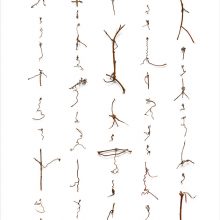Cui Fei (The Sandal Dome)
Cui Fei (b. 1970, Jinan, China) received her MFA in Painting at Indiana University of Pennsylvania, and her BFA from the China Academy of Fine Arts. Cui’s works have been exhibited nationally and internationally at venues such as the Museum of Arts and Design, New York, NY; Princeton University Art Museum, Princeton, NJ; Queens Museum, NY; Aldrich Contemporary Art Museum, Ridgefield, CT; New Britain Museum of American Art, New Britain, CT; Jeju Museum of Art, Jeju, Korea; Rietberg Museum Zurich, Switzerland; Museum of East Asian Art in Cologne, Germany, among others. Her work is included in the permanent collections of the Princeton University Art Museum; the Tang Center for East Asian Art at Princeton University; Light Work; and Stony Brook University.
————————————————————————————————————————————————————————————————————————————————————————————————————————————————————————————————————
Tracing the Origin VI—I-III
In my on-going series “Tracing the Origin,” I use “Chinese characters” as the subject to explore the relationship between human beings and nature. Chinese writing originated from nature as ideograms, over time the characters were simplified, abstracted and separated from their original context, their origin is no longer recognizable. My work takes a similar tack. I began working with grape tendrils—the found gestures look like Chinese calligraphy strokes written in grass style. I transformed them into two-dimensional works of different colors and scales or into three-dimensional works made with varied materials. As a result, the tendrils cannot be easily identified in the finished work. Different media used in this series, such as installation, printmaking, and photography, are intended to symbolize how Chinese written characters have become detached from their origin; and by inference, how humans have also detached themselves from nature. In “Tracing the Origin VI,” I chose to use photography to transform the three dimensional objects into a two dimensional print. To make this work, the tendrils were first assembled on three large panels in a Chinese calligraphic composition. After being recorded by an 8×10 camera, this unique composition was dismantled and no longer exists. The large format camera is able to capture tremendous details and give a vivid representation of the tendrils.
The Broken Moral Code
The chapter “The Sandal Dome” in the book Haft Paykar, tells a story that conveys one of the universal, timeless moral codes: good deeds will be rewarded and bad deeds will be punished. I translated the expressions of this idiom from both Chinese and English into Braille and marked each dot with ink. The torn and aged papyrus is intended to simulate a relic, expressing my observation that this code is not always valid in reality.





